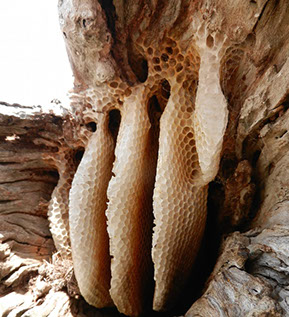
INSTALLATIONS
HOME ABOUT FABRICATIONS CALLS COMPETITIONS KEYNOTES PRESENTERS INSTALLATIONS SCHEDULE QUOTES REGISTER PRACTICALITIES
DUSTIN D. WIEBE, Research in Residence at the Centre for Architectural Structures and Technology
LAWRENCE BIRD, Winnipeg
NIKOLE BOUCHARD, University of Wisconsin
BEEbrane
Every year thousands of natural disasters strike cities like a chain saw, toppling street trees and destroying thousands more in urban parks and woodlands. Municipalities across North America make constant efforts to rid their city streets and parks of tree debris and fallen branches. The BEEbrane is an on-going design research project that proposes to convert fallen urban tree debris and salvaged wood materials into new homes for urban flora and fauna, with a specific focus on the creation of urban honeybee habitats. The BEEbrane takes inspiration from one of the oldest and most natural forms of bee keeping for both its formal and conceptual framework – a hollowed-out trunk cavity called a Bee Gum. This form of habitat provides an environment that protects the hives from threatening weather conditions, like rain, wind, frost and snow. The BEEbrane reduces urban waste, enhances environmental biodiversity and invites people to experience ever-changing processes within nature.
The BEEbrane is an interdisciplinary project that operates in the space between art, architecture, landscape and science to create productive urban placemaking strategies. The research and design process requires contact and communication with various local organizations to identify, locate, quantify and collect wood waste materials. This includes correspondence with a number of local groups, ranging from the city parks department, to non-profit urban wood organizations, to local lumber mill owners. Additionally, collaborations with area beekeepers and ecologists are an integral part of the design development process.
This BEEbrane is a temporary 2018 Atmosphere Symposium installation produced in a collaborative design workshop setting, where students will work with locally sourced wood waste to produce urban honey bee habitat prototypes. The BEEbrane demands that we work with what’s at hand.
For information on the BEEbrane collaborative student workshop on January 30, click here
GYUNGJU CHYON & JOHN SADAR, Parsons School of Design
LANCELOT COAR, University of Manitoba
JORGE RIVERA & RYAN STEC, Carleton University
Temporal Lines - Spiraling Time in the Non-Space of VRs
MYUNG DUK CHUNG
Mediating Fabrics: Poetic Canvas
MICHAEL BUTTERWORTH

photo: Sarah Stasiuk [M2 Architecture]

The 2018 Atmosphere Symposium is co-chaired by: Lisa Landrum and Liane Veness with the support of the Faculty's Cultural Events Committee and the Centre for Architectural Structure and Technology (C.A.S.T.); web design and graphics support by Tali Budman (ED4 Architecture student), and administrative support from Brandy O’Reilly (Faculty of Architecture, Partners Program).
Questions? Please contact info@atmos.ca